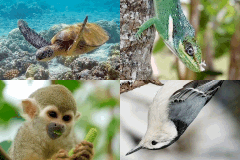AnAge entry for Strongylocentrotus franciscanus
Strongylocentrotus franciscanus is a species with negligible senescence
Classification (HAGRID: 04232)
- Taxonomy
-
Kingdom: Animalia
Phylum: Echinodermata
Class: Echinoidea
Order: Echinoida
Family: Strongylocentrotidae
Genus: Strongylocentrotus
- Species
- Strongylocentrotus franciscanus
- Common name
- Red sea urchin
Lifespan, ageing, and relevant traits
- IMR
- Not yet available
- MRDT
- No MRDT detected
- Maximum longevity
- 200 years (wild)
- Source
- ref. 40
- Sample size
- Medium
- Data quality
- Acceptable
- Observations
The red sea urchin shows no noticeable signs of ageing. It is considered a species with negligible senescence. Estimates suggest these animals might live up to 200 years in the wild [0040], with no age-related increase in mortality rate or decline in reproductive capacity. They attain sexual maturity in about 1-2 years [0591]. Longer lived species of sea urchins have thicker shells and spines and more genes associated with innate immunity, indicating greater defence mechanisms. One study demonstrated low levels of cell proliferation and apoptosis within the internal tissues, in keeping with their low metabolic rates [1225].
Life history traits (averages)
- No information is available on life history. Please contact us if you wish to suggest or contribute data.
Metabolism
No information on metabolism is available.
References
- [1225] Bodnar and Coffman (2016), Maintenance of somatic tissue regeneration with age in short- and long-lived species of sea urchins (PubMed)
- [1234] Sergiev et al. (2016), Genomes of Strongylocentrotus franciscanus and Lytechinus variegatus: are there any genomic explanations for the two order of magnitude difference in the lifespan of sea urchins? (PubMed)
- [1224] Bodnar (2015), Cellular and molecular mechanisms of negligible senescence: insight from the sea urchin (PubMed)
- [0833] Ebert (2008), Longevity and lack of senescence in the red sea urchin Strongylocentrotus franciscanus (PubMed)
- [0959] Francis et al. (2006), Lack of age-associated telomere shortening in long- and short-lived species of sea urchins (PubMed)
- [0040] Ebert and Southon (2003), Red sea urchins (Strongylocentrotus franciscanus) can live over 100 years: confirmation with A-bomb 14carbon
- [0591] Edwin Iversen and Kay Hale (1992), Aquaculture Sourcebook: A Guide to North American Species
- [1235] Lahiri (1976), Kinetics of haemopoietic recovery in endotoxin-treated mice (PubMed)
External Resources
- Integrated Taxonomic Information System
- ITIS 157971
- Animal Diversity Web
- ADW account
- Encyclopaedia of Life
- Search EOL
- NCBI Taxonomy
- Taxonomy ID 7665
- Entrez
- Search all databases
- Ageing Literature
- Search Google Scholar or Search PubMed
- Images
- Google Image search
- Internet
- Search Google

